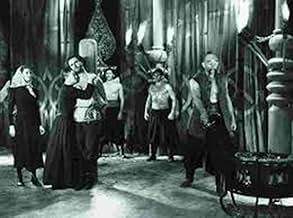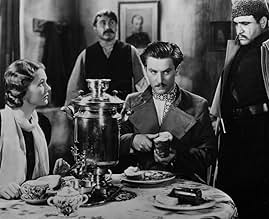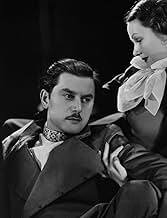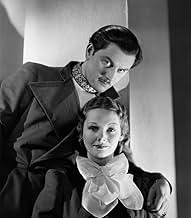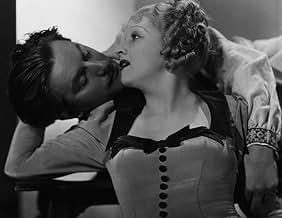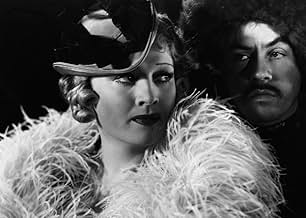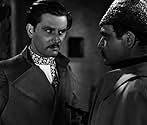NOTE IMDb
6,2/10
286
MA NOTE
Ajouter une intrigue dans votre langueA Russian courier struggles to deliver a message to the troops fighting Tartar invaders.A Russian courier struggles to deliver a message to the troops fighting Tartar invaders.A Russian courier struggles to deliver a message to the troops fighting Tartar invaders.
- Réalisation
- Scénario
- Casting principal
- Récompenses
- 1 victoire au total
Oscar Apfel
- Tsar's General
- (non crédité)
Margaret Armstrong
- Gypsy Woman
- (non crédité)
Matthew Betz
- Chieftain
- (non crédité)
Ward Bond
- Tartar Guard
- (non crédité)
Lynton Brent
- Sailor
- (non crédité)
Leonard Ceeley
- Tsar's Aide
- (non crédité)
Harry Cording
- Peasant
- (non crédité)
Avis à la une
THE ADVENTURES OF MICHAEL STROGOFF (aka THE SOLDIER AND THE LADY) is a strange little movie. At first glance it's an American production, but then it turns out to be a version of a French version of a German movie. Confused yet? In essence, lots of footage is taken from the European original(s) with some added-in sub-plots involving a couple of comic relief characters commentating on the action.
The film is a fairly typical swashbuckler for the era, ostensibly based on a Jules Verne story. The fact that it involves the Russian Empire makes for a refreshing change, but otherwise it's business as usual. The bad guys are dastardly and of the moustache-twirling variety while the hero is put through the mill during the course of the production.
There are certainly some rousing bits of spectacle along the way, including well-filmed horse and carriage chases. The ending is inevitably stirring, with a nice twist. Strogoff gets the chance to indulge in some fisticuffs with a bear and is later subjected to a torture scene straight out of a FU MANCHU movie. It's all heavily dated so only those with a nostalgic eye for the era will likely enjoy it.
The film is a fairly typical swashbuckler for the era, ostensibly based on a Jules Verne story. The fact that it involves the Russian Empire makes for a refreshing change, but otherwise it's business as usual. The bad guys are dastardly and of the moustache-twirling variety while the hero is put through the mill during the course of the production.
There are certainly some rousing bits of spectacle along the way, including well-filmed horse and carriage chases. The ending is inevitably stirring, with a nice twist. Strogoff gets the chance to indulge in some fisticuffs with a bear and is later subjected to a torture scene straight out of a FU MANCHU movie. It's all heavily dated so only those with a nostalgic eye for the era will likely enjoy it.
I'm giving 6 to this film, well below it's current ranking at IMDb, and just for the powerful scenes that remain in it, from the original French production "Michel Strogoff" aka "Der Kurier des Zaren" (1936), by German director Richard Eichberg. The introduction of two comic-relief characters speaks a lot of the lack of culture, ethics, and common-sense of the American producers who concocted this version, re-issued under a different title yet, in 1945, in which Akim Tamiroff was given first credits - to bank on his 1940 public acknowledgement in "The Way of All Flesh". Speaking of flesh, Michel Strogoff is whip-tortured by Ogareff in front of his mother, and girl friend: first you see his naked torso (from the Franco-German film), and then you see him in tattered shirt (from the American added footage)... As if the Russian outlaws would decide to cover the man's torso after the first set of whip-lashes! Since the earlier film is impossible to view these days, I guess we must put up with this version to have glimpses of the former greatness of battles, horse charges, and human emotions - like that silent suffering mother. A pity Eichberg is not credited for the only good footage in this film.
MICHEL STROGOFF is my favorite Jules Verne book. From the title I could never tell that it was an adaptation of Verne's opus, but THE SOLDIER AND THE LADY, the 1937 Hollywood version, is probably the best rendition I have watched of the great novel.
Director George Nicholls Jr does a fine job of keeping the story on track despite the multitude of characters that appear in it. The cinematography by Joseph August is very good, much better than what one would see in films back in the day. I was reminded at times of Eisenstein's ALEXANDER NEVSKI, even if the latter only came out the following year.
Anton Walbrook seems a bit puny for the part but he delivers a well etched portrayal of the character, even if I found that he kept bulging his eyes wide open more than the part needed.
Exuberance was much more in keeping with the part of Ogareff, which Akim Tamiroff delivers in flamboyant style, easily stealing the show.
Pity that the Hollywoodization of this wonderful literary work would have to include the then almost obligatory comic relief, personified by Blore and Brophy as war correspondents. They have no connection with the English and French newsmen of the original. Elizabeth Allan seems weak.
Those shortcomings aside, this film is well worth watching.
Director George Nicholls Jr does a fine job of keeping the story on track despite the multitude of characters that appear in it. The cinematography by Joseph August is very good, much better than what one would see in films back in the day. I was reminded at times of Eisenstein's ALEXANDER NEVSKI, even if the latter only came out the following year.
Anton Walbrook seems a bit puny for the part but he delivers a well etched portrayal of the character, even if I found that he kept bulging his eyes wide open more than the part needed.
Exuberance was much more in keeping with the part of Ogareff, which Akim Tamiroff delivers in flamboyant style, easily stealing the show.
Pity that the Hollywoodization of this wonderful literary work would have to include the then almost obligatory comic relief, personified by Blore and Brophy as war correspondents. They have no connection with the English and French newsmen of the original. Elizabeth Allan seems weak.
Those shortcomings aside, this film is well worth watching.
I saw this wonderful film when I was 15 in 1940, a local cinema in Barcelona and still love very much as well as the nostalgia that surrounds those days of black and white film that we like so much. talking about the film in its technical, special effects and perfect interpretation; all area perfect. "I don't know why they are doing chariot races - is nothing these races they made already in the Roman Empire" - commentary between the two journalists in the carriage - the interpretation of Anton Walbrook is memorable, as well as the rest of actors and actresses. scenarios are beautiful even in black and white, great staging of the thousands of extras and the Russian cavalry and tartar. Anton Walbrook in the role of Michael Strogoff is great, as well as Akim Tamiroff in the role of Ogareff, Fay Bainter is exquisite and sweet as the hero's mother, Elizabeth Allan as the girlfriend of Michel Strogoff is so beautiful and sweet as the heroines of those times, finally a great movie that I never tire of seeing and seeing.
Tsarist courier Michael Strogoff has an important message to deliver to Grand Duke Vladimir. Rebel leader Ivan Ogareff is rampaging in Siberia. Strogoff falls for Nadia. He picks up two comedic reporters and survives Tartar revolt along the way.
There seems to be different versions and this one has been edited from an earlier one. I can't really tell and I don't have the ability to compare any of them. It's a fine action adventure thriller. There is some good action, some really big action. This could be more personal. The big action do take over in the second half.
There seems to be different versions and this one has been edited from an earlier one. I can't really tell and I don't have the ability to compare any of them. It's a fine action adventure thriller. There is some good action, some really big action. This could be more personal. The big action do take over in the second half.
Le saviez-vous
- AnecdotesRKO bought the rights to the French version Michel Strogoff (1936) for $75,000, and specifically signed its star Anton Walbrook so that they could use some scenes from that movie. About 22 scenes were edited into the new version, including Siberia footage, battle footage, Tartar camps and the river on fire. The Hollywood Reporter mentioned that the new footage shot blended perfectly with the old footage.
- GaffesWhen Strogoff is being chased on horseback from Omsk, the horse trips in an open area well within view of those chasing him. Yet just after he falls, he is suddenly in a wooded area and he is able to hide himself as his chasers just ride on past.
- Citations
Cart Driver: I take your money, you take a walk.
Henry Blount: I say, but that's most frightfully one sided.
- Crédits fousOpening credits: 1870 During the reign of Tsar Alexander II, the fate of the Russian Empire was threatened by a great Tartar uprising in Siberia ......
- ConnexionsEdited from Der Kurier des Zaren (1936)
- Bandes originalesGod Save the Tsar
(1833) (uncredited)
(Russian national anthem, 1833-1917)
Music by Alexis Lvov
Variations often in the score
Meilleurs choix
Connectez-vous pour évaluer et suivre la liste de favoris afin de recevoir des recommandations personnalisées
Détails
- Date de sortie
- Pays d’origine
- Langue
- Aussi connu sous le nom de
- Michael Strogoff
- Lieux de tournage
- Société de production
- Voir plus de crédits d'entreprise sur IMDbPro
Box-office
- Budget
- 400 000 $US (estimé)
- Durée1 heure 25 minutes
- Couleur
- Rapport de forme
- 1.37 : 1
Contribuer à cette page
Suggérer une modification ou ajouter du contenu manquant

Lacune principale
By what name was Michel Strogoff (1937) officially released in Canada in English?
Répondre
